University of Pretoria: Disruptive Innovation Research Proposal
VerifiedAdded on 2022/10/19
|21
|5639
|28
Project
AI Summary
This research proposal, submitted in partial fulfillment of a PhD in Business Management at the University of Pretoria, investigates the significance of disruptive innovation in contemporary business environments, specifically focusing on strategies for Small and Medium-sized Enterprises (SMEs). The study aims to understand how disruptive innovation impacts organizations and to develop effective adoption strategies for SMEs. The proposal outlines a mixed research methodology, including a non-probability persuasive sampling method for data collection and a detailed examination of the background, research problem, purpose, and ethical considerations. The research acknowledges the challenges SMEs face in adopting disruptive technologies, such as the need for informed strategic choices and the pressure from larger organizations. It emphasizes the importance of understanding disruptive innovation beyond technology, focusing on its application within business functions, and addressing the need for SMEs to strategically leverage technological advancements to maintain competitiveness in the dynamic market. The study will contribute to the understanding of how SMEs can navigate the competitive landscape through innovative strategies.
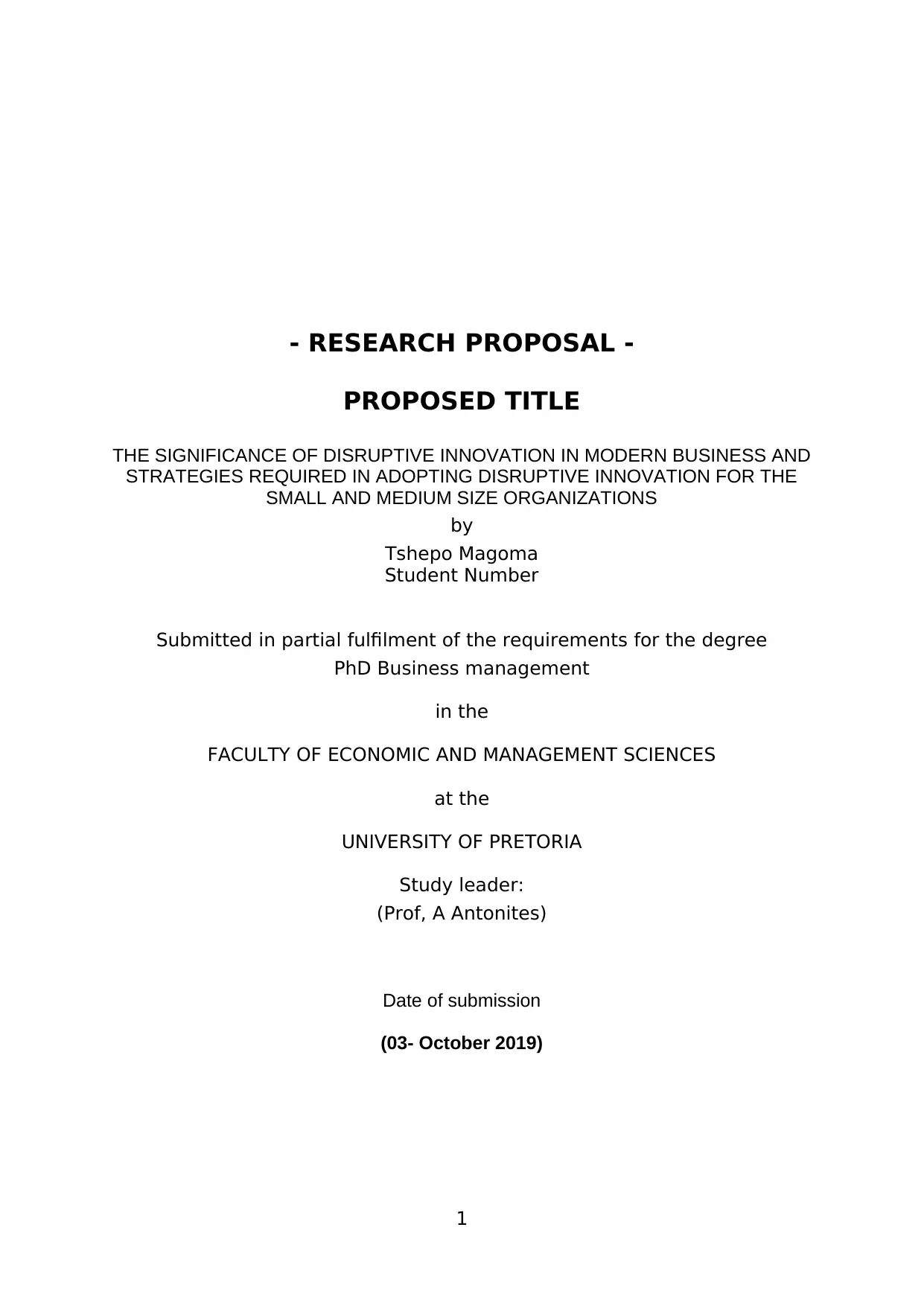
- RESEARCH PROPOSAL -
PROPOSED TITLE
THE SIGNIFICANCE OF DISRUPTIVE INNOVATION IN MODERN BUSINESS AND
STRATEGIES REQUIRED IN ADOPTING DISRUPTIVE INNOVATION FOR THE
SMALL AND MEDIUM SIZE ORGANIZATIONS
by
Tshepo Magoma
Student Number
Submitted in partial fulfilment of the requirements for the degree
PhD Business management
in the
FACULTY OF ECONOMIC AND MANAGEMENT SCIENCES
at the
UNIVERSITY OF PRETORIA
Study leader:
(Prof, A Antonites)
Date of submission
(03- October 2019)
1
PROPOSED TITLE
THE SIGNIFICANCE OF DISRUPTIVE INNOVATION IN MODERN BUSINESS AND
STRATEGIES REQUIRED IN ADOPTING DISRUPTIVE INNOVATION FOR THE
SMALL AND MEDIUM SIZE ORGANIZATIONS
by
Tshepo Magoma
Student Number
Submitted in partial fulfilment of the requirements for the degree
PhD Business management
in the
FACULTY OF ECONOMIC AND MANAGEMENT SCIENCES
at the
UNIVERSITY OF PRETORIA
Study leader:
(Prof, A Antonites)
Date of submission
(03- October 2019)
1
Paraphrase This Document
Need a fresh take? Get an instant paraphrase of this document with our AI Paraphraser
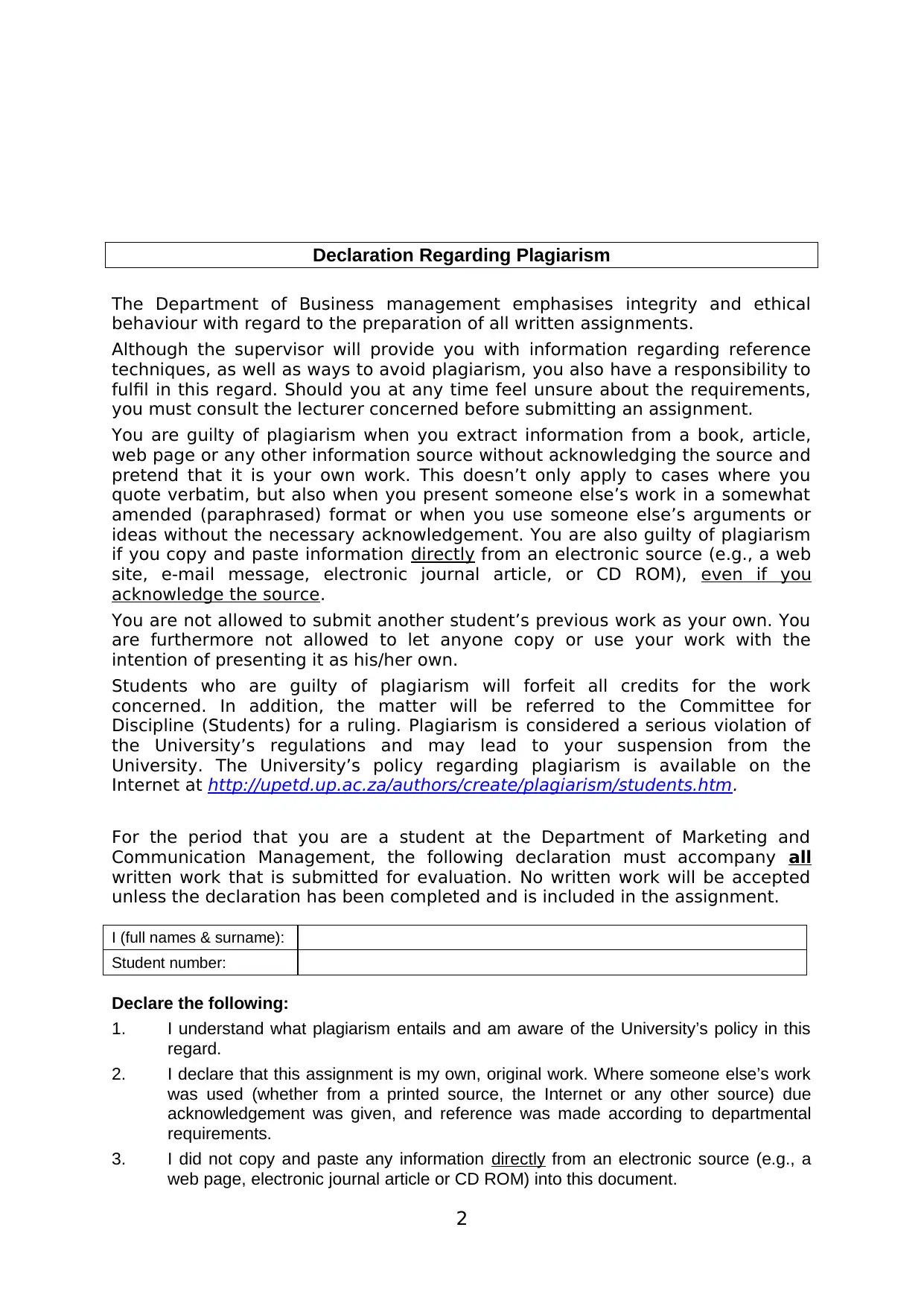
Declaration Regarding Plagiarism
The Department of Business management emphasises integrity and ethical
behaviour with regard to the preparation of all written assignments.
Although the supervisor will provide you with information regarding reference
techniques, as well as ways to avoid plagiarism, you also have a responsibility to
fulfil in this regard. Should you at any time feel unsure about the requirements,
you must consult the lecturer concerned before submitting an assignment.
You are guilty of plagiarism when you extract information from a book, article,
web page or any other information source without acknowledging the source and
pretend that it is your own work. This doesn’t only apply to cases where you
quote verbatim, but also when you present someone else’s work in a somewhat
amended (paraphrased) format or when you use someone else’s arguments or
ideas without the necessary acknowledgement. You are also guilty of plagiarism
if you copy and paste information directly from an electronic source (e.g., a web
site, e-mail message, electronic journal article, or CD ROM), even if you
acknowledge the source.
You are not allowed to submit another student’s previous work as your own. You
are furthermore not allowed to let anyone copy or use your work with the
intention of presenting it as his/her own.
Students who are guilty of plagiarism will forfeit all credits for the work
concerned. In addition, the matter will be referred to the Committee for
Discipline (Students) for a ruling. Plagiarism is considered a serious violation of
the University’s regulations and may lead to your suspension from the
University. The University’s policy regarding plagiarism is available on the
Internet at http://upetd.up.ac.za/authors/create/plagiarism/students.htm.
For the period that you are a student at the Department of Marketing and
Communication Management, the following declaration must accompany all
written work that is submitted for evaluation. No written work will be accepted
unless the declaration has been completed and is included in the assignment.
I (full names & surname):
Student number:
Declare the following:
1. I understand what plagiarism entails and am aware of the University’s policy in this
regard.
2. I declare that this assignment is my own, original work. Where someone else’s work
was used (whether from a printed source, the Internet or any other source) due
acknowledgement was given, and reference was made according to departmental
requirements.
3. I did not copy and paste any information directly from an electronic source (e.g., a
web page, electronic journal article or CD ROM) into this document.
2
The Department of Business management emphasises integrity and ethical
behaviour with regard to the preparation of all written assignments.
Although the supervisor will provide you with information regarding reference
techniques, as well as ways to avoid plagiarism, you also have a responsibility to
fulfil in this regard. Should you at any time feel unsure about the requirements,
you must consult the lecturer concerned before submitting an assignment.
You are guilty of plagiarism when you extract information from a book, article,
web page or any other information source without acknowledging the source and
pretend that it is your own work. This doesn’t only apply to cases where you
quote verbatim, but also when you present someone else’s work in a somewhat
amended (paraphrased) format or when you use someone else’s arguments or
ideas without the necessary acknowledgement. You are also guilty of plagiarism
if you copy and paste information directly from an electronic source (e.g., a web
site, e-mail message, electronic journal article, or CD ROM), even if you
acknowledge the source.
You are not allowed to submit another student’s previous work as your own. You
are furthermore not allowed to let anyone copy or use your work with the
intention of presenting it as his/her own.
Students who are guilty of plagiarism will forfeit all credits for the work
concerned. In addition, the matter will be referred to the Committee for
Discipline (Students) for a ruling. Plagiarism is considered a serious violation of
the University’s regulations and may lead to your suspension from the
University. The University’s policy regarding plagiarism is available on the
Internet at http://upetd.up.ac.za/authors/create/plagiarism/students.htm.
For the period that you are a student at the Department of Marketing and
Communication Management, the following declaration must accompany all
written work that is submitted for evaluation. No written work will be accepted
unless the declaration has been completed and is included in the assignment.
I (full names & surname):
Student number:
Declare the following:
1. I understand what plagiarism entails and am aware of the University’s policy in this
regard.
2. I declare that this assignment is my own, original work. Where someone else’s work
was used (whether from a printed source, the Internet or any other source) due
acknowledgement was given, and reference was made according to departmental
requirements.
3. I did not copy and paste any information directly from an electronic source (e.g., a
web page, electronic journal article or CD ROM) into this document.
2

4. I did not make use of another student’s previous work and submitted it as my own.
5. I did not allow and will not allow anyone to copy my work with the intention of
presenting it as his/her own work.
Signature Date
3
5. I did not allow and will not allow anyone to copy my work with the intention of
presenting it as his/her own work.
Signature Date
3
⊘ This is a preview!⊘
Do you want full access?
Subscribe today to unlock all pages.

Trusted by 1+ million students worldwide
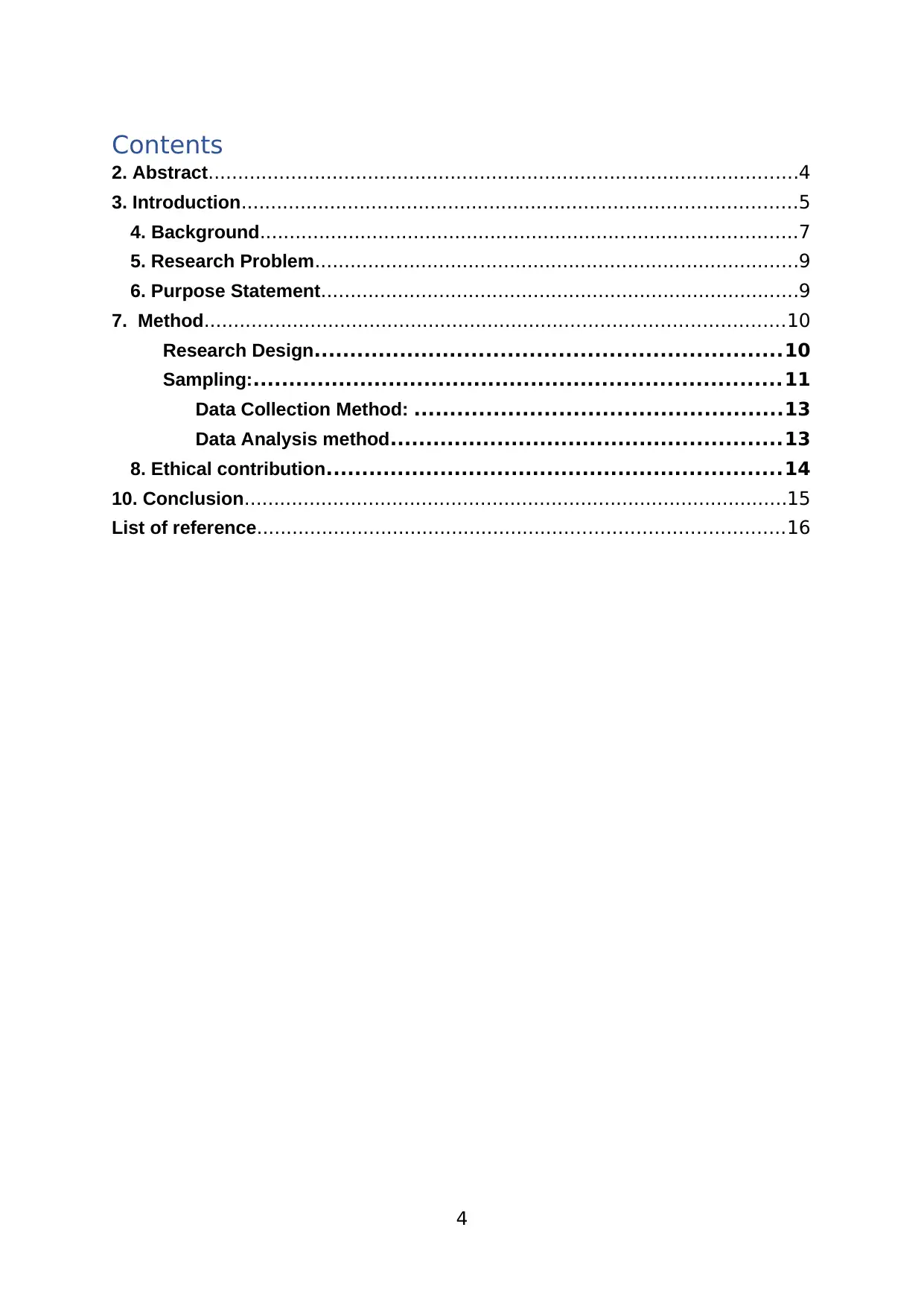
Contents
2. Abstract....................................................................................................4
3. Introduction..............................................................................................5
4. Background...........................................................................................7
5. Research Problem..................................................................................9
6. Purpose Statement.................................................................................9
7. Method..................................................................................................10
Research Design.................................................................10
Sampling:..........................................................................11
Data Collection Method: ...................................................13
Data Analysis method.......................................................13
8. Ethical contribution................................................................14
10. Conclusion............................................................................................15
List of reference.........................................................................................16
4
2. Abstract....................................................................................................4
3. Introduction..............................................................................................5
4. Background...........................................................................................7
5. Research Problem..................................................................................9
6. Purpose Statement.................................................................................9
7. Method..................................................................................................10
Research Design.................................................................10
Sampling:..........................................................................11
Data Collection Method: ...................................................13
Data Analysis method.......................................................13
8. Ethical contribution................................................................14
10. Conclusion............................................................................................15
List of reference.........................................................................................16
4
Paraphrase This Document
Need a fresh take? Get an instant paraphrase of this document with our AI Paraphraser
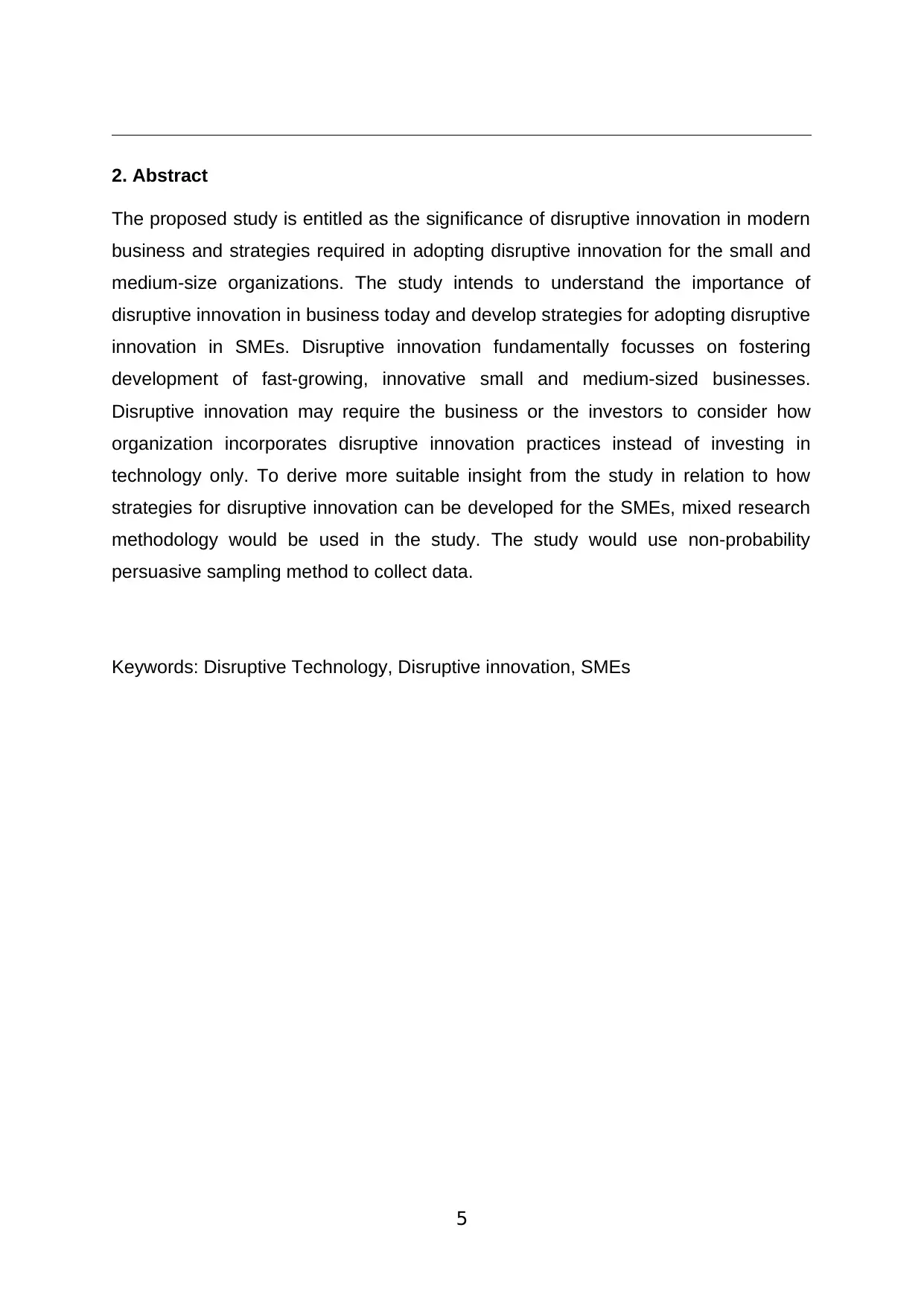
2. Abstract
The proposed study is entitled as the significance of disruptive innovation in modern
business and strategies required in adopting disruptive innovation for the small and
medium-size organizations. The study intends to understand the importance of
disruptive innovation in business today and develop strategies for adopting disruptive
innovation in SMEs. Disruptive innovation fundamentally focusses on fostering
development of fast-growing, innovative small and medium-sized businesses.
Disruptive innovation may require the business or the investors to consider how
organization incorporates disruptive innovation practices instead of investing in
technology only. To derive more suitable insight from the study in relation to how
strategies for disruptive innovation can be developed for the SMEs, mixed research
methodology would be used in the study. The study would use non-probability
persuasive sampling method to collect data.
Keywords: Disruptive Technology, Disruptive innovation, SMEs
5
The proposed study is entitled as the significance of disruptive innovation in modern
business and strategies required in adopting disruptive innovation for the small and
medium-size organizations. The study intends to understand the importance of
disruptive innovation in business today and develop strategies for adopting disruptive
innovation in SMEs. Disruptive innovation fundamentally focusses on fostering
development of fast-growing, innovative small and medium-sized businesses.
Disruptive innovation may require the business or the investors to consider how
organization incorporates disruptive innovation practices instead of investing in
technology only. To derive more suitable insight from the study in relation to how
strategies for disruptive innovation can be developed for the SMEs, mixed research
methodology would be used in the study. The study would use non-probability
persuasive sampling method to collect data.
Keywords: Disruptive Technology, Disruptive innovation, SMEs
5
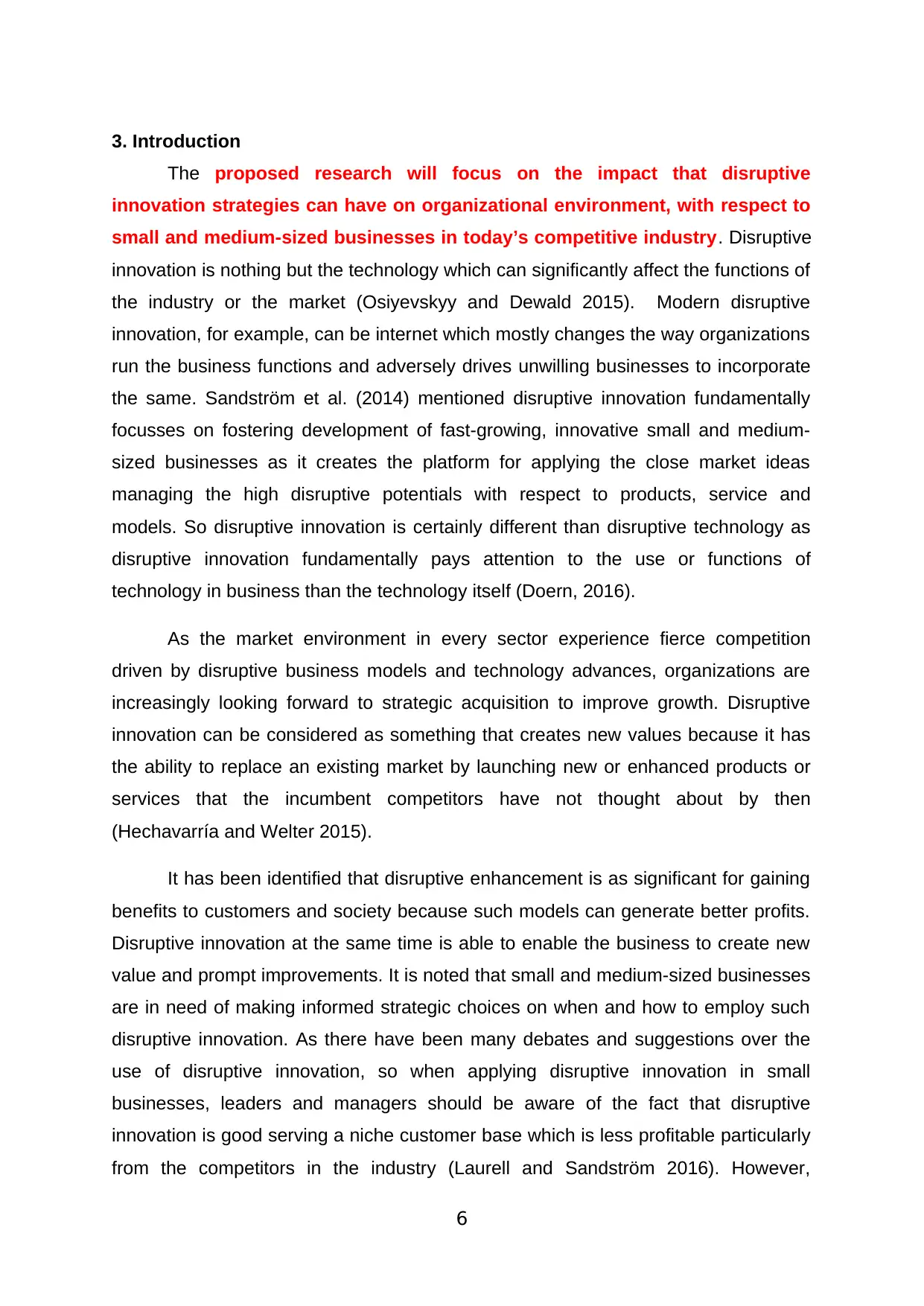
3. Introduction
The proposed research will focus on the impact that disruptive
innovation strategies can have on organizational environment, with respect to
small and medium-sized businesses in today’s competitive industry. Disruptive
innovation is nothing but the technology which can significantly affect the functions of
the industry or the market (Osiyevskyy and Dewald 2015). Modern disruptive
innovation, for example, can be internet which mostly changes the way organizations
run the business functions and adversely drives unwilling businesses to incorporate
the same. Sandström et al. (2014) mentioned disruptive innovation fundamentally
focusses on fostering development of fast-growing, innovative small and medium-
sized businesses as it creates the platform for applying the close market ideas
managing the high disruptive potentials with respect to products, service and
models. So disruptive innovation is certainly different than disruptive technology as
disruptive innovation fundamentally pays attention to the use or functions of
technology in business than the technology itself (Doern, 2016).
As the market environment in every sector experience fierce competition
driven by disruptive business models and technology advances, organizations are
increasingly looking forward to strategic acquisition to improve growth. Disruptive
innovation can be considered as something that creates new values because it has
the ability to replace an existing market by launching new or enhanced products or
services that the incumbent competitors have not thought about by then
(Hechavarría and Welter 2015).
It has been identified that disruptive enhancement is as significant for gaining
benefits to customers and society because such models can generate better profits.
Disruptive innovation at the same time is able to enable the business to create new
value and prompt improvements. It is noted that small and medium-sized businesses
are in need of making informed strategic choices on when and how to employ such
disruptive innovation. As there have been many debates and suggestions over the
use of disruptive innovation, so when applying disruptive innovation in small
businesses, leaders and managers should be aware of the fact that disruptive
innovation is good serving a niche customer base which is less profitable particularly
from the competitors in the industry (Laurell and Sandström 2016). However,
6
The proposed research will focus on the impact that disruptive
innovation strategies can have on organizational environment, with respect to
small and medium-sized businesses in today’s competitive industry. Disruptive
innovation is nothing but the technology which can significantly affect the functions of
the industry or the market (Osiyevskyy and Dewald 2015). Modern disruptive
innovation, for example, can be internet which mostly changes the way organizations
run the business functions and adversely drives unwilling businesses to incorporate
the same. Sandström et al. (2014) mentioned disruptive innovation fundamentally
focusses on fostering development of fast-growing, innovative small and medium-
sized businesses as it creates the platform for applying the close market ideas
managing the high disruptive potentials with respect to products, service and
models. So disruptive innovation is certainly different than disruptive technology as
disruptive innovation fundamentally pays attention to the use or functions of
technology in business than the technology itself (Doern, 2016).
As the market environment in every sector experience fierce competition
driven by disruptive business models and technology advances, organizations are
increasingly looking forward to strategic acquisition to improve growth. Disruptive
innovation can be considered as something that creates new values because it has
the ability to replace an existing market by launching new or enhanced products or
services that the incumbent competitors have not thought about by then
(Hechavarría and Welter 2015).
It has been identified that disruptive enhancement is as significant for gaining
benefits to customers and society because such models can generate better profits.
Disruptive innovation at the same time is able to enable the business to create new
value and prompt improvements. It is noted that small and medium-sized businesses
are in need of making informed strategic choices on when and how to employ such
disruptive innovation. As there have been many debates and suggestions over the
use of disruptive innovation, so when applying disruptive innovation in small
businesses, leaders and managers should be aware of the fact that disruptive
innovation is good serving a niche customer base which is less profitable particularly
from the competitors in the industry (Laurell and Sandström 2016). However,
6
⊘ This is a preview!⊘
Do you want full access?
Subscribe today to unlock all pages.

Trusted by 1+ million students worldwide
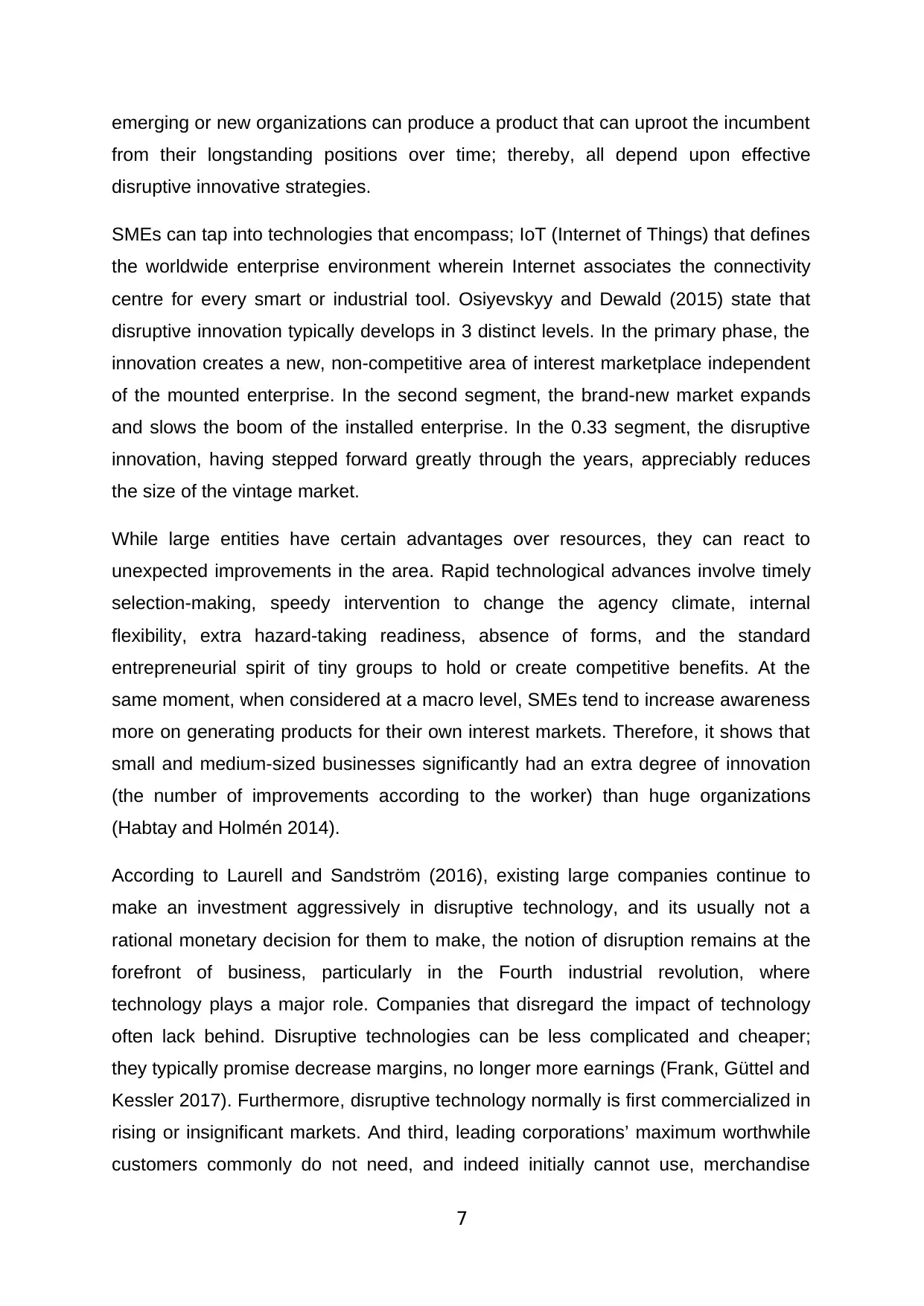
emerging or new organizations can produce a product that can uproot the incumbent
from their longstanding positions over time; thereby, all depend upon effective
disruptive innovative strategies.
SMEs can tap into technologies that encompass; IoT (Internet of Things) that defines
the worldwide enterprise environment wherein Internet associates the connectivity
centre for every smart or industrial tool. Osiyevskyy and Dewald (2015) state that
disruptive innovation typically develops in 3 distinct levels. In the primary phase, the
innovation creates a new, non-competitive area of interest marketplace independent
of the mounted enterprise. In the second segment, the brand-new market expands
and slows the boom of the installed enterprise. In the 0.33 segment, the disruptive
innovation, having stepped forward greatly through the years, appreciably reduces
the size of the vintage market.
While large entities have certain advantages over resources, they can react to
unexpected improvements in the area. Rapid technological advances involve timely
selection-making, speedy intervention to change the agency climate, internal
flexibility, extra hazard-taking readiness, absence of forms, and the standard
entrepreneurial spirit of tiny groups to hold or create competitive benefits. At the
same moment, when considered at a macro level, SMEs tend to increase awareness
more on generating products for their own interest markets. Therefore, it shows that
small and medium-sized businesses significantly had an extra degree of innovation
(the number of improvements according to the worker) than huge organizations
(Habtay and Holmén 2014).
According to Laurell and Sandström (2016), existing large companies continue to
make an investment aggressively in disruptive technology, and its usually not a
rational monetary decision for them to make, the notion of disruption remains at the
forefront of business, particularly in the Fourth industrial revolution, where
technology plays a major role. Companies that disregard the impact of technology
often lack behind. Disruptive technologies can be less complicated and cheaper;
they typically promise decrease margins, no longer more earnings (Frank, Güttel and
Kessler 2017). Furthermore, disruptive technology normally is first commercialized in
rising or insignificant markets. And third, leading corporations’ maximum worthwhile
customers commonly do not need, and indeed initially cannot use, merchandise
7
from their longstanding positions over time; thereby, all depend upon effective
disruptive innovative strategies.
SMEs can tap into technologies that encompass; IoT (Internet of Things) that defines
the worldwide enterprise environment wherein Internet associates the connectivity
centre for every smart or industrial tool. Osiyevskyy and Dewald (2015) state that
disruptive innovation typically develops in 3 distinct levels. In the primary phase, the
innovation creates a new, non-competitive area of interest marketplace independent
of the mounted enterprise. In the second segment, the brand-new market expands
and slows the boom of the installed enterprise. In the 0.33 segment, the disruptive
innovation, having stepped forward greatly through the years, appreciably reduces
the size of the vintage market.
While large entities have certain advantages over resources, they can react to
unexpected improvements in the area. Rapid technological advances involve timely
selection-making, speedy intervention to change the agency climate, internal
flexibility, extra hazard-taking readiness, absence of forms, and the standard
entrepreneurial spirit of tiny groups to hold or create competitive benefits. At the
same moment, when considered at a macro level, SMEs tend to increase awareness
more on generating products for their own interest markets. Therefore, it shows that
small and medium-sized businesses significantly had an extra degree of innovation
(the number of improvements according to the worker) than huge organizations
(Habtay and Holmén 2014).
According to Laurell and Sandström (2016), existing large companies continue to
make an investment aggressively in disruptive technology, and its usually not a
rational monetary decision for them to make, the notion of disruption remains at the
forefront of business, particularly in the Fourth industrial revolution, where
technology plays a major role. Companies that disregard the impact of technology
often lack behind. Disruptive technologies can be less complicated and cheaper;
they typically promise decrease margins, no longer more earnings (Frank, Güttel and
Kessler 2017). Furthermore, disruptive technology normally is first commercialized in
rising or insignificant markets. And third, leading corporations’ maximum worthwhile
customers commonly do not need, and indeed initially cannot use, merchandise
7
Paraphrase This Document
Need a fresh take? Get an instant paraphrase of this document with our AI Paraphraser
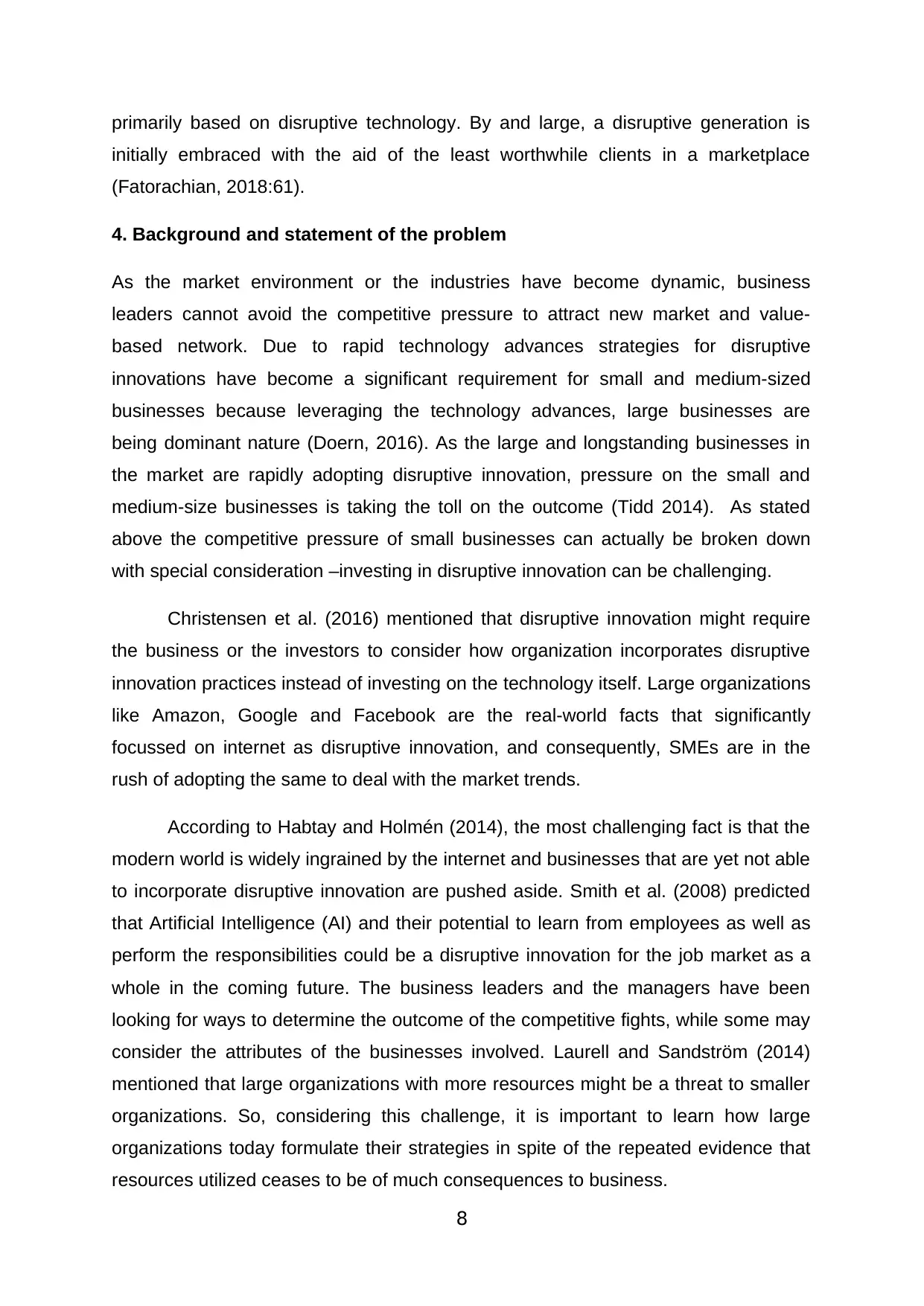
primarily based on disruptive technology. By and large, a disruptive generation is
initially embraced with the aid of the least worthwhile clients in a marketplace
(Fatorachian, 2018:61).
4. Background and statement of the problem
As the market environment or the industries have become dynamic, business
leaders cannot avoid the competitive pressure to attract new market and value-
based network. Due to rapid technology advances strategies for disruptive
innovations have become a significant requirement for small and medium-sized
businesses because leveraging the technology advances, large businesses are
being dominant nature (Doern, 2016). As the large and longstanding businesses in
the market are rapidly adopting disruptive innovation, pressure on the small and
medium-size businesses is taking the toll on the outcome (Tidd 2014). As stated
above the competitive pressure of small businesses can actually be broken down
with special consideration –investing in disruptive innovation can be challenging.
Christensen et al. (2016) mentioned that disruptive innovation might require
the business or the investors to consider how organization incorporates disruptive
innovation practices instead of investing on the technology itself. Large organizations
like Amazon, Google and Facebook are the real-world facts that significantly
focussed on internet as disruptive innovation, and consequently, SMEs are in the
rush of adopting the same to deal with the market trends.
According to Habtay and Holmén (2014), the most challenging fact is that the
modern world is widely ingrained by the internet and businesses that are yet not able
to incorporate disruptive innovation are pushed aside. Smith et al. (2008) predicted
that Artificial Intelligence (AI) and their potential to learn from employees as well as
perform the responsibilities could be a disruptive innovation for the job market as a
whole in the coming future. The business leaders and the managers have been
looking for ways to determine the outcome of the competitive fights, while some may
consider the attributes of the businesses involved. Laurell and Sandström (2014)
mentioned that large organizations with more resources might be a threat to smaller
organizations. So, considering this challenge, it is important to learn how large
organizations today formulate their strategies in spite of the repeated evidence that
resources utilized ceases to be of much consequences to business.
8
initially embraced with the aid of the least worthwhile clients in a marketplace
(Fatorachian, 2018:61).
4. Background and statement of the problem
As the market environment or the industries have become dynamic, business
leaders cannot avoid the competitive pressure to attract new market and value-
based network. Due to rapid technology advances strategies for disruptive
innovations have become a significant requirement for small and medium-sized
businesses because leveraging the technology advances, large businesses are
being dominant nature (Doern, 2016). As the large and longstanding businesses in
the market are rapidly adopting disruptive innovation, pressure on the small and
medium-size businesses is taking the toll on the outcome (Tidd 2014). As stated
above the competitive pressure of small businesses can actually be broken down
with special consideration –investing in disruptive innovation can be challenging.
Christensen et al. (2016) mentioned that disruptive innovation might require
the business or the investors to consider how organization incorporates disruptive
innovation practices instead of investing on the technology itself. Large organizations
like Amazon, Google and Facebook are the real-world facts that significantly
focussed on internet as disruptive innovation, and consequently, SMEs are in the
rush of adopting the same to deal with the market trends.
According to Habtay and Holmén (2014), the most challenging fact is that the
modern world is widely ingrained by the internet and businesses that are yet not able
to incorporate disruptive innovation are pushed aside. Smith et al. (2008) predicted
that Artificial Intelligence (AI) and their potential to learn from employees as well as
perform the responsibilities could be a disruptive innovation for the job market as a
whole in the coming future. The business leaders and the managers have been
looking for ways to determine the outcome of the competitive fights, while some may
consider the attributes of the businesses involved. Laurell and Sandström (2014)
mentioned that large organizations with more resources might be a threat to smaller
organizations. So, considering this challenge, it is important to learn how large
organizations today formulate their strategies in spite of the repeated evidence that
resources utilized ceases to be of much consequences to business.
8
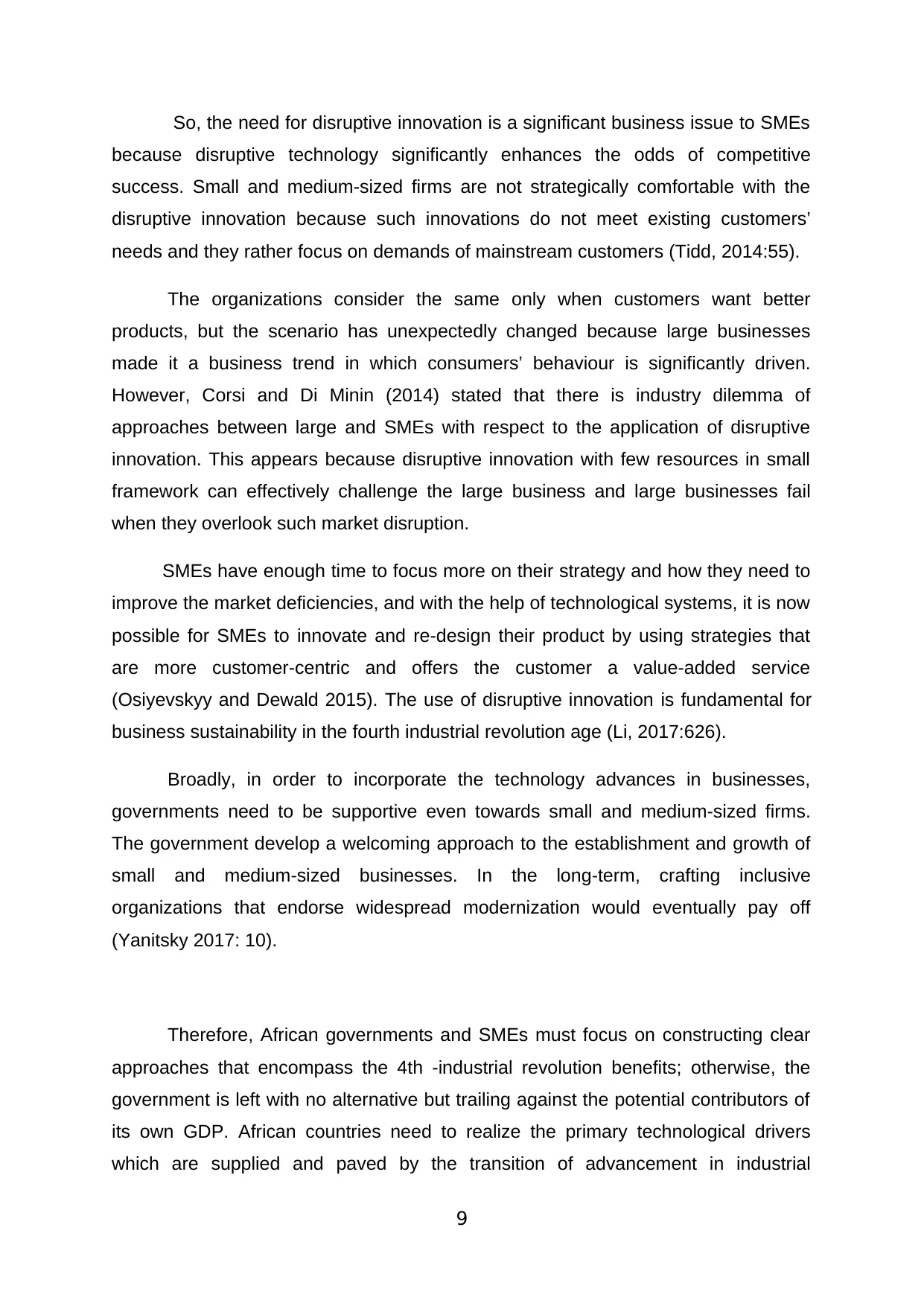
So, the need for disruptive innovation is a significant business issue to SMEs
because disruptive technology significantly enhances the odds of competitive
success. Small and medium-sized firms are not strategically comfortable with the
disruptive innovation because such innovations do not meet existing customers’
needs and they rather focus on demands of mainstream customers (Tidd, 2014:55).
The organizations consider the same only when customers want better
products, but the scenario has unexpectedly changed because large businesses
made it a business trend in which consumers’ behaviour is significantly driven.
However, Corsi and Di Minin (2014) stated that there is industry dilemma of
approaches between large and SMEs with respect to the application of disruptive
innovation. This appears because disruptive innovation with few resources in small
framework can effectively challenge the large business and large businesses fail
when they overlook such market disruption.
SMEs have enough time to focus more on their strategy and how they need to
improve the market deficiencies, and with the help of technological systems, it is now
possible for SMEs to innovate and re-design their product by using strategies that
are more customer-centric and offers the customer a value-added service
(Osiyevskyy and Dewald 2015). The use of disruptive innovation is fundamental for
business sustainability in the fourth industrial revolution age (Li, 2017:626).
Broadly, in order to incorporate the technology advances in businesses,
governments need to be supportive even towards small and medium-sized firms.
The government develop a welcoming approach to the establishment and growth of
small and medium-sized businesses. In the long-term, crafting inclusive
organizations that endorse widespread modernization would eventually pay off
(Yanitsky 2017: 10).
Therefore, African governments and SMEs must focus on constructing clear
approaches that encompass the 4th -industrial revolution benefits; otherwise, the
government is left with no alternative but trailing against the potential contributors of
its own GDP. African countries need to realize the primary technological drivers
which are supplied and paved by the transition of advancement in industrial
9
because disruptive technology significantly enhances the odds of competitive
success. Small and medium-sized firms are not strategically comfortable with the
disruptive innovation because such innovations do not meet existing customers’
needs and they rather focus on demands of mainstream customers (Tidd, 2014:55).
The organizations consider the same only when customers want better
products, but the scenario has unexpectedly changed because large businesses
made it a business trend in which consumers’ behaviour is significantly driven.
However, Corsi and Di Minin (2014) stated that there is industry dilemma of
approaches between large and SMEs with respect to the application of disruptive
innovation. This appears because disruptive innovation with few resources in small
framework can effectively challenge the large business and large businesses fail
when they overlook such market disruption.
SMEs have enough time to focus more on their strategy and how they need to
improve the market deficiencies, and with the help of technological systems, it is now
possible for SMEs to innovate and re-design their product by using strategies that
are more customer-centric and offers the customer a value-added service
(Osiyevskyy and Dewald 2015). The use of disruptive innovation is fundamental for
business sustainability in the fourth industrial revolution age (Li, 2017:626).
Broadly, in order to incorporate the technology advances in businesses,
governments need to be supportive even towards small and medium-sized firms.
The government develop a welcoming approach to the establishment and growth of
small and medium-sized businesses. In the long-term, crafting inclusive
organizations that endorse widespread modernization would eventually pay off
(Yanitsky 2017: 10).
Therefore, African governments and SMEs must focus on constructing clear
approaches that encompass the 4th -industrial revolution benefits; otherwise, the
government is left with no alternative but trailing against the potential contributors of
its own GDP. African countries need to realize the primary technological drivers
which are supplied and paved by the transition of advancement in industrial
9
⊘ This is a preview!⊘
Do you want full access?
Subscribe today to unlock all pages.

Trusted by 1+ million students worldwide
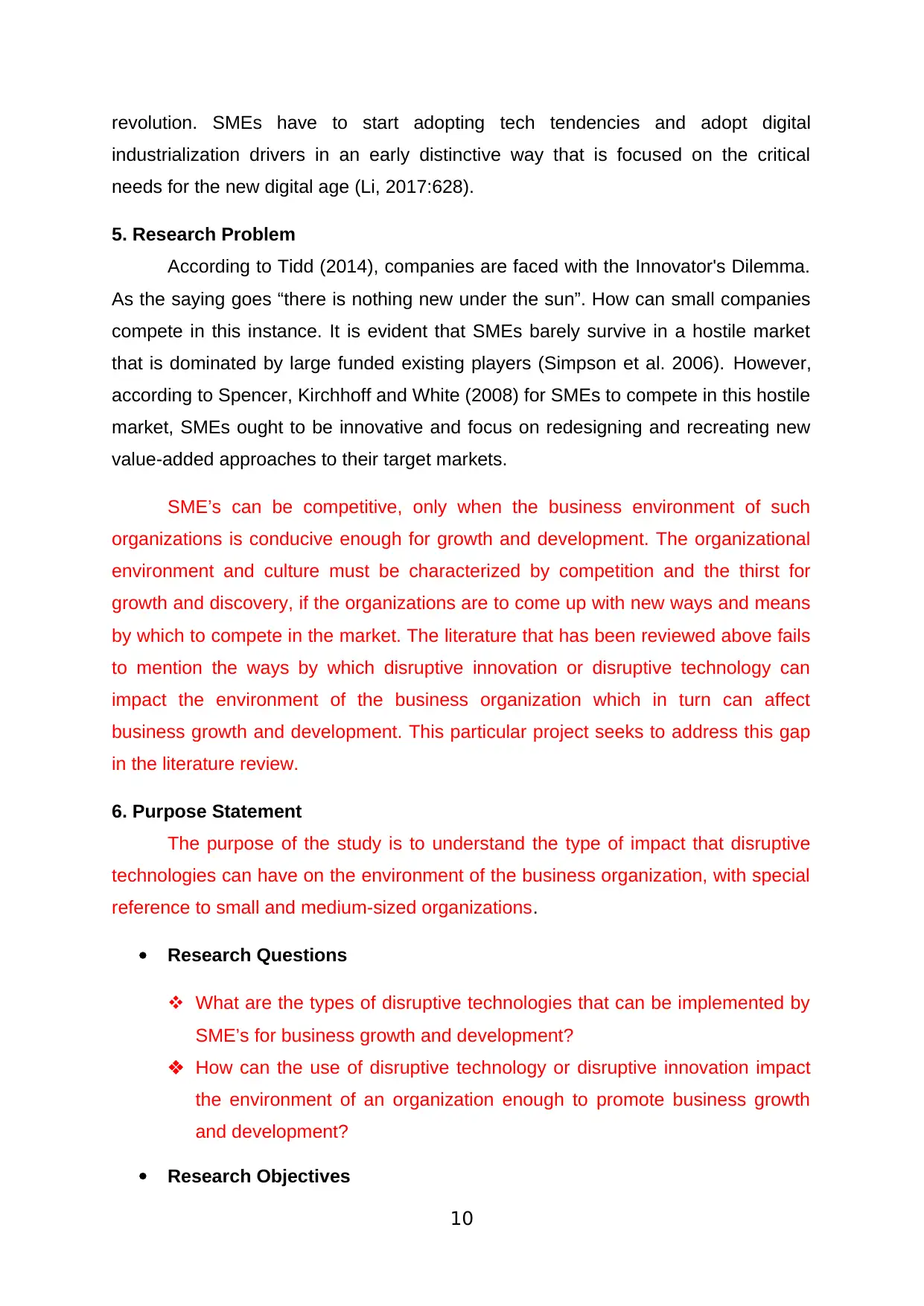
revolution. SMEs have to start adopting tech tendencies and adopt digital
industrialization drivers in an early distinctive way that is focused on the critical
needs for the new digital age (Li, 2017:628).
5. Research Problem
According to Tidd (2014), companies are faced with the Innovator's Dilemma.
As the saying goes “there is nothing new under the sun”. How can small companies
compete in this instance. It is evident that SMEs barely survive in a hostile market
that is dominated by large funded existing players (Simpson et al. 2006). However,
according to Spencer, Kirchhoff and White (2008) for SMEs to compete in this hostile
market, SMEs ought to be innovative and focus on redesigning and recreating new
value-added approaches to their target markets.
SME’s can be competitive, only when the business environment of such
organizations is conducive enough for growth and development. The organizational
environment and culture must be characterized by competition and the thirst for
growth and discovery, if the organizations are to come up with new ways and means
by which to compete in the market. The literature that has been reviewed above fails
to mention the ways by which disruptive innovation or disruptive technology can
impact the environment of the business organization which in turn can affect
business growth and development. This particular project seeks to address this gap
in the literature review.
6. Purpose Statement
The purpose of the study is to understand the type of impact that disruptive
technologies can have on the environment of the business organization, with special
reference to small and medium-sized organizations.
Research Questions
What are the types of disruptive technologies that can be implemented by
SME’s for business growth and development?
How can the use of disruptive technology or disruptive innovation impact
the environment of an organization enough to promote business growth
and development?
Research Objectives
10
industrialization drivers in an early distinctive way that is focused on the critical
needs for the new digital age (Li, 2017:628).
5. Research Problem
According to Tidd (2014), companies are faced with the Innovator's Dilemma.
As the saying goes “there is nothing new under the sun”. How can small companies
compete in this instance. It is evident that SMEs barely survive in a hostile market
that is dominated by large funded existing players (Simpson et al. 2006). However,
according to Spencer, Kirchhoff and White (2008) for SMEs to compete in this hostile
market, SMEs ought to be innovative and focus on redesigning and recreating new
value-added approaches to their target markets.
SME’s can be competitive, only when the business environment of such
organizations is conducive enough for growth and development. The organizational
environment and culture must be characterized by competition and the thirst for
growth and discovery, if the organizations are to come up with new ways and means
by which to compete in the market. The literature that has been reviewed above fails
to mention the ways by which disruptive innovation or disruptive technology can
impact the environment of the business organization which in turn can affect
business growth and development. This particular project seeks to address this gap
in the literature review.
6. Purpose Statement
The purpose of the study is to understand the type of impact that disruptive
technologies can have on the environment of the business organization, with special
reference to small and medium-sized organizations.
Research Questions
What are the types of disruptive technologies that can be implemented by
SME’s for business growth and development?
How can the use of disruptive technology or disruptive innovation impact
the environment of an organization enough to promote business growth
and development?
Research Objectives
10
Paraphrase This Document
Need a fresh take? Get an instant paraphrase of this document with our AI Paraphraser
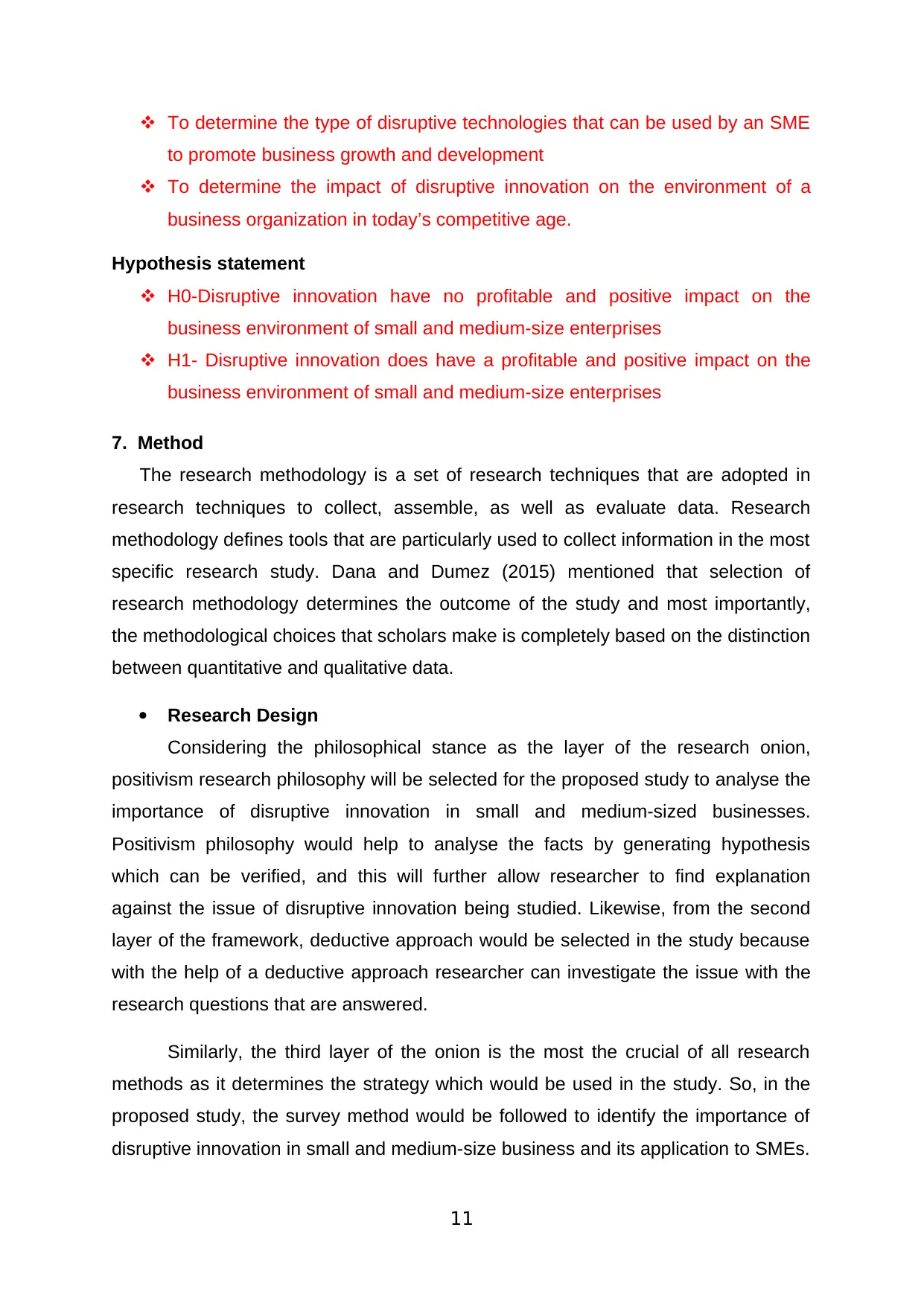
To determine the type of disruptive technologies that can be used by an SME
to promote business growth and development
To determine the impact of disruptive innovation on the environment of a
business organization in today’s competitive age.
Hypothesis statement
H0-Disruptive innovation have no profitable and positive impact on the
business environment of small and medium-size enterprises
H1- Disruptive innovation does have a profitable and positive impact on the
business environment of small and medium-size enterprises
7. Method
The research methodology is a set of research techniques that are adopted in
research techniques to collect, assemble, as well as evaluate data. Research
methodology defines tools that are particularly used to collect information in the most
specific research study. Dana and Dumez (2015) mentioned that selection of
research methodology determines the outcome of the study and most importantly,
the methodological choices that scholars make is completely based on the distinction
between quantitative and qualitative data.
Research Design
Considering the philosophical stance as the layer of the research onion,
positivism research philosophy will be selected for the proposed study to analyse the
importance of disruptive innovation in small and medium-sized businesses.
Positivism philosophy would help to analyse the facts by generating hypothesis
which can be verified, and this will further allow researcher to find explanation
against the issue of disruptive innovation being studied. Likewise, from the second
layer of the framework, deductive approach would be selected in the study because
with the help of a deductive approach researcher can investigate the issue with the
research questions that are answered.
Similarly, the third layer of the onion is the most the crucial of all research
methods as it determines the strategy which would be used in the study. So, in the
proposed study, the survey method would be followed to identify the importance of
disruptive innovation in small and medium-size business and its application to SMEs.
11
to promote business growth and development
To determine the impact of disruptive innovation on the environment of a
business organization in today’s competitive age.
Hypothesis statement
H0-Disruptive innovation have no profitable and positive impact on the
business environment of small and medium-size enterprises
H1- Disruptive innovation does have a profitable and positive impact on the
business environment of small and medium-size enterprises
7. Method
The research methodology is a set of research techniques that are adopted in
research techniques to collect, assemble, as well as evaluate data. Research
methodology defines tools that are particularly used to collect information in the most
specific research study. Dana and Dumez (2015) mentioned that selection of
research methodology determines the outcome of the study and most importantly,
the methodological choices that scholars make is completely based on the distinction
between quantitative and qualitative data.
Research Design
Considering the philosophical stance as the layer of the research onion,
positivism research philosophy will be selected for the proposed study to analyse the
importance of disruptive innovation in small and medium-sized businesses.
Positivism philosophy would help to analyse the facts by generating hypothesis
which can be verified, and this will further allow researcher to find explanation
against the issue of disruptive innovation being studied. Likewise, from the second
layer of the framework, deductive approach would be selected in the study because
with the help of a deductive approach researcher can investigate the issue with the
research questions that are answered.
Similarly, the third layer of the onion is the most the crucial of all research
methods as it determines the strategy which would be used in the study. So, in the
proposed study, the survey method would be followed to identify the importance of
disruptive innovation in small and medium-size business and its application to SMEs.
11
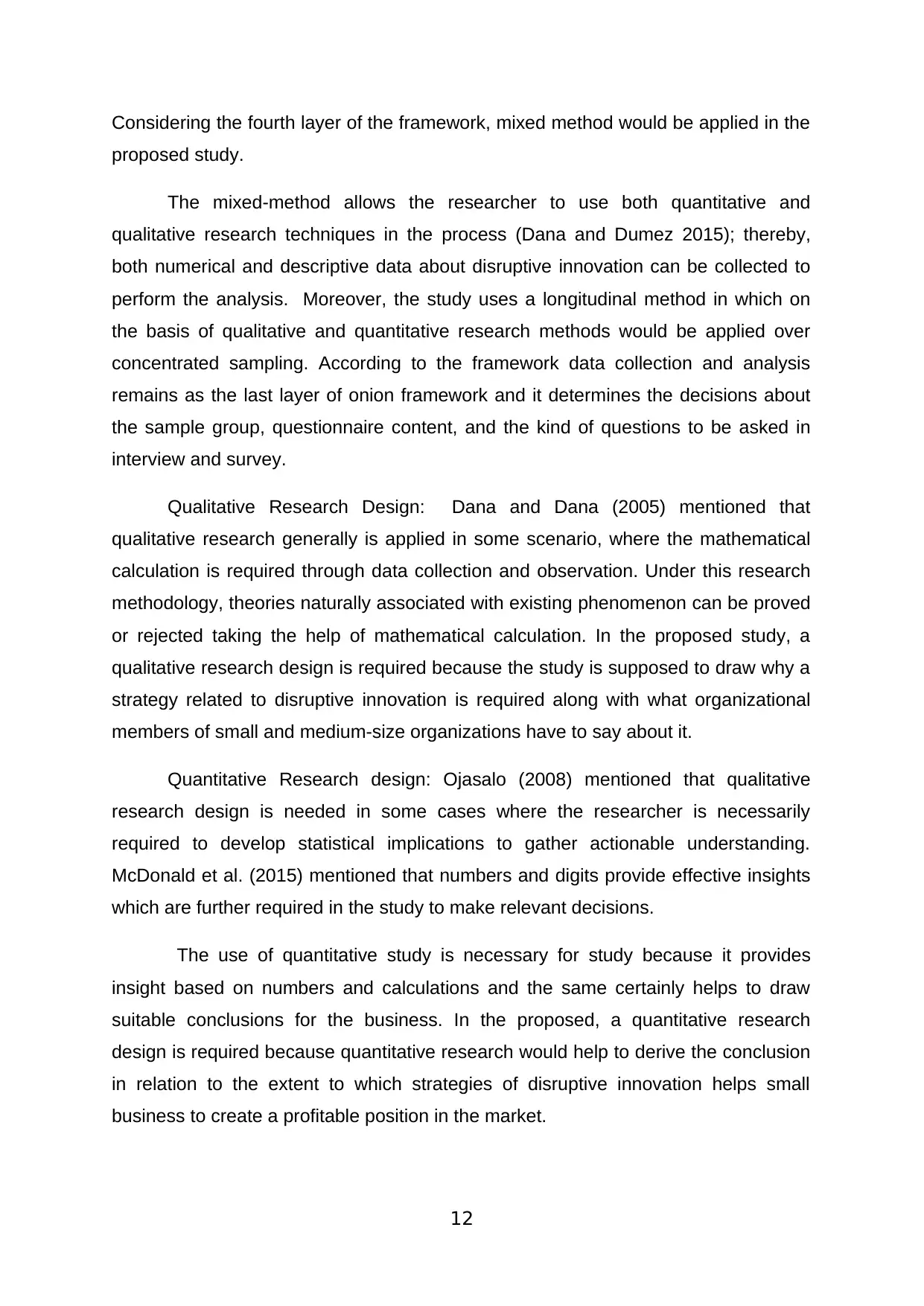
Considering the fourth layer of the framework, mixed method would be applied in the
proposed study.
The mixed-method allows the researcher to use both quantitative and
qualitative research techniques in the process (Dana and Dumez 2015); thereby,
both numerical and descriptive data about disruptive innovation can be collected to
perform the analysis. Moreover, the study uses a longitudinal method in which on
the basis of qualitative and quantitative research methods would be applied over
concentrated sampling. According to the framework data collection and analysis
remains as the last layer of onion framework and it determines the decisions about
the sample group, questionnaire content, and the kind of questions to be asked in
interview and survey.
Qualitative Research Design: Dana and Dana (2005) mentioned that
qualitative research generally is applied in some scenario, where the mathematical
calculation is required through data collection and observation. Under this research
methodology, theories naturally associated with existing phenomenon can be proved
or rejected taking the help of mathematical calculation. In the proposed study, a
qualitative research design is required because the study is supposed to draw why a
strategy related to disruptive innovation is required along with what organizational
members of small and medium-size organizations have to say about it.
Quantitative Research design: Ojasalo (2008) mentioned that qualitative
research design is needed in some cases where the researcher is necessarily
required to develop statistical implications to gather actionable understanding.
McDonald et al. (2015) mentioned that numbers and digits provide effective insights
which are further required in the study to make relevant decisions.
The use of quantitative study is necessary for study because it provides
insight based on numbers and calculations and the same certainly helps to draw
suitable conclusions for the business. In the proposed, a quantitative research
design is required because quantitative research would help to derive the conclusion
in relation to the extent to which strategies of disruptive innovation helps small
business to create a profitable position in the market.
12
proposed study.
The mixed-method allows the researcher to use both quantitative and
qualitative research techniques in the process (Dana and Dumez 2015); thereby,
both numerical and descriptive data about disruptive innovation can be collected to
perform the analysis. Moreover, the study uses a longitudinal method in which on
the basis of qualitative and quantitative research methods would be applied over
concentrated sampling. According to the framework data collection and analysis
remains as the last layer of onion framework and it determines the decisions about
the sample group, questionnaire content, and the kind of questions to be asked in
interview and survey.
Qualitative Research Design: Dana and Dana (2005) mentioned that
qualitative research generally is applied in some scenario, where the mathematical
calculation is required through data collection and observation. Under this research
methodology, theories naturally associated with existing phenomenon can be proved
or rejected taking the help of mathematical calculation. In the proposed study, a
qualitative research design is required because the study is supposed to draw why a
strategy related to disruptive innovation is required along with what organizational
members of small and medium-size organizations have to say about it.
Quantitative Research design: Ojasalo (2008) mentioned that qualitative
research design is needed in some cases where the researcher is necessarily
required to develop statistical implications to gather actionable understanding.
McDonald et al. (2015) mentioned that numbers and digits provide effective insights
which are further required in the study to make relevant decisions.
The use of quantitative study is necessary for study because it provides
insight based on numbers and calculations and the same certainly helps to draw
suitable conclusions for the business. In the proposed, a quantitative research
design is required because quantitative research would help to derive the conclusion
in relation to the extent to which strategies of disruptive innovation helps small
business to create a profitable position in the market.
12
⊘ This is a preview!⊘
Do you want full access?
Subscribe today to unlock all pages.

Trusted by 1+ million students worldwide
1 out of 21
Related Documents
Your All-in-One AI-Powered Toolkit for Academic Success.
+13062052269
info@desklib.com
Available 24*7 on WhatsApp / Email
![[object Object]](/_next/static/media/star-bottom.7253800d.svg)
Unlock your academic potential
Copyright © 2020–2025 A2Z Services. All Rights Reserved. Developed and managed by ZUCOL.





